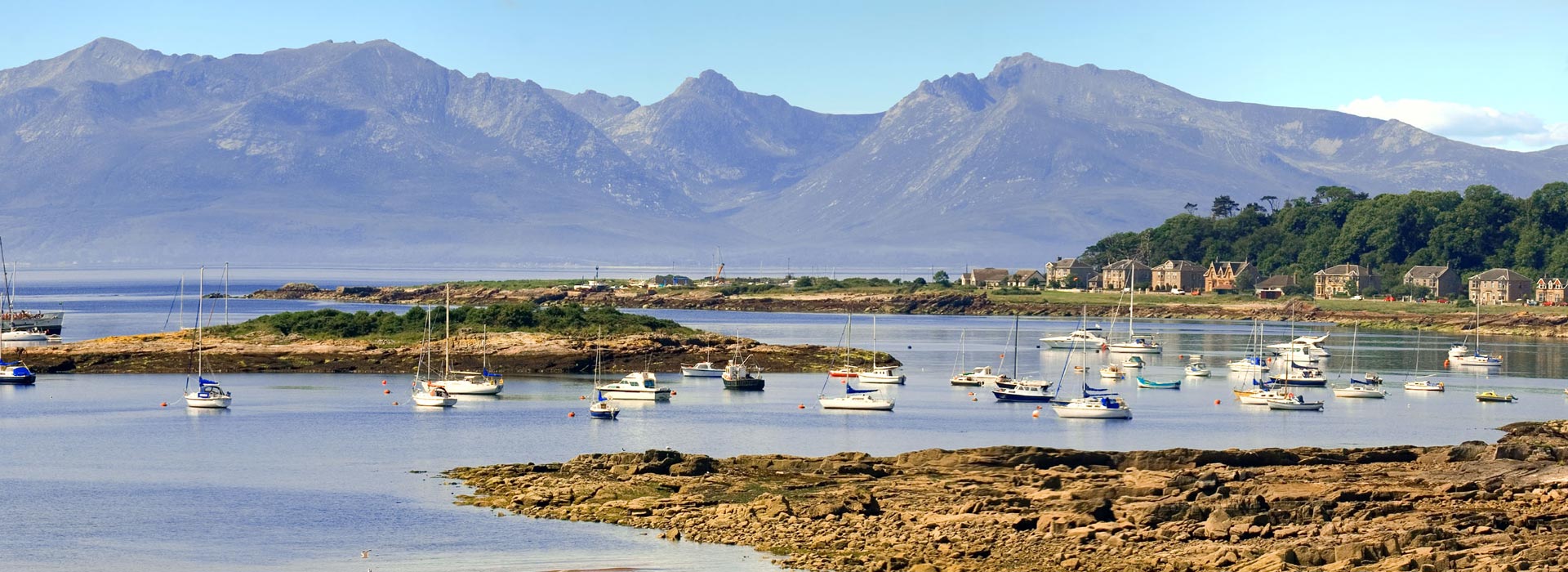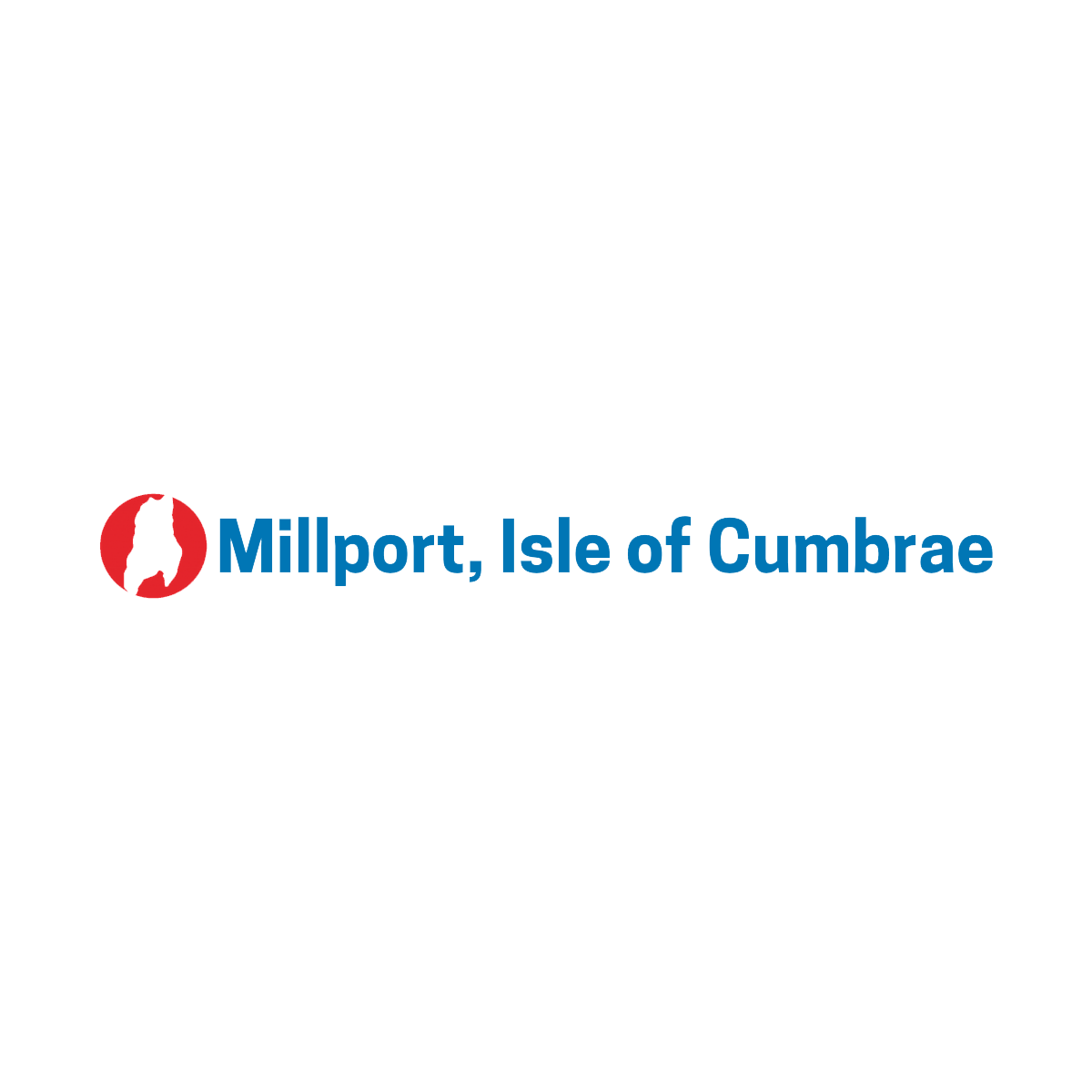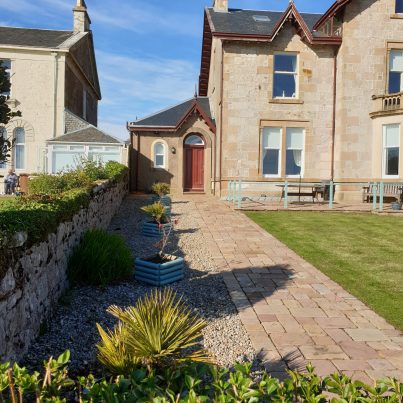About
Learn about this special island and what to do

The Isle of Cumbrae, also known as Great Cumbrae, lies on the Ayrshire coast and is roughly four miles long and two miles wide. The circumference of the island is very much up for debate with many people not managing to settle on an exact distance however it is measured without argument as 10.25 miles (16.5km) round (if you go left or counter clockwise). If however you use modern technology and plan my cycle it says 9.9 miles.
The island is just a short ferry trip of under 15 minutes from Largs, this has allowed Cumbrae to become regarded as Scotland’s most accessible island.
Marine Environment and Wildlife
Local wildlike includes owls, polecats, rabbits, common kestrels, buzzards, and the occasional golden eagle and sea eagle, as well as a large seabird population: fulmars, cormorants, oystercatchers and many more. Other marine life includes seal, basking sharks, porbeagle sharks, porpoise, dolphins, minky and orca whales.
History
The island has been inhabited since the end of the last ice age.
Legend has it that St Mirin, on his return to Scotland from Ireland around AD 710, arrived in Cumbrae and, following the example of St Patrick, rid the island of snakes. The Cathedral of the Isles is reputed to have been built on the site where St Mirin preached. Cumbrae to this day remains snake-free.
In 1263, Haakon IV, King of Norway, may have used the eastern coast of the island as an anchorage for his fleet, before the inconclusive Battle of Largs. Ballochmartin Bay and Portrye (derived from Gaelic elements meaning “king’s harbour”) are suggested locations for the Norwegian-anchorage.
For many centuries the island was under shared ownership, with the Marquess of Bute in the west and the Earl of Glasgow in the east. In 1999 the final feudal landowner, Le Mans winner Johnny Dumfries, now Bute, of Mount Stuart House, put the island up for general sale, with first refusal given to his farmer tenants.
Tourism grew in the 20th century, and Millport became a popular stop for Clyde steamers and families going ‘Doon the Watter for the Fair’ (Glasgow Fair holidays). Today most visitors are daytrippers, mostly due to the growth of foreign package holidays in the 1960s. It is still possible to experience a traditional day out on the PS Waverley which operates from both Glasgow and Ayr during the summer.
Millport a seaside town
The only settlement is Millport, a seaside town with a Victorian promenade which curves around an attractive hilly bay on the south coast. Millport is home to Britain’s smallest cathedral, the Cathedral of the Isles, which was completed in 1851 to a design by William Butterfield, one of the leading Gothic revival architects of the day.
Originally the villages of Kames and Kirkton overlooked different ends of the bay that forms most of Great Cumbrae’s south coast, but they gradually grew together as Millport.
From the mid 1700s Millport was used as a base for a fast customs cutter, ideally placed to keep track of shipping passing through the Firth of Clyde. The ship’s captain built a barracks on the seafront to accommodate the crew, which became known as The Garrison. The Garrison was remodelled in 1819-20 when it became the family home of the island’s owner, Lord Glasgow.
In 1833 Lord Glasgow built a pier at Millport and the town rapidly became a regular port of call for Clyde steamers. It also grew as the island holiday resort of choice for the Victorian chattering classes.
In 1849 the 6th Lord Glasgow funded the building of a theological college in Millport. The building was completed in 1851, and in 1876 it was consecrated as the Cathedral of the Isles. It remains a must-see part of any visit to the island.
Despite a boycott in 1906 over harbour dues, Millport was an important stopping off point for Clyde steamers until the 1960s: and it remains a regular port of call for the Waverley, the world’s last sea-going paddle steamer. The town was for many years the terminus for a direct passenger ferry link to Largs and Wemyss Bay, but this ceased with the advent of the roll-on roll-off services to the newly-built Cumbrae Slip in 1972.
Today’s Millport retains its sandy beaches and slightly old-world resort feel. It’s especially popular with cyclists, most doing the 10 mile circuit of the island on bikes.
With the Cathedral of the Isles set back from the sea, the most striking building in any view along or across Millport Bay is Garrison House. This is the name now given to what was previously known as The Garrison. Until 1997 this was used as council offices, but it was then abandoned due to its poor condition. A fire in 2001 did little to improve matters. Thankfully a major restoration has since been completed, resulting in a rebirth of this magnificent building. It now provides a range of community facilities including the Museum of the Cumbraes, a library, and a cafe, plus medical services and council offices. It also does much to improve the appearance of the whole of the centre of Millport.
Millport itself is remarkably linear. It extends for the better part of two miles along the shore, yet for much of that length is only one or two streets deep. Garrison House provides a focal point, both geographically and in terms of community activity. But if the town can be said to have a heart, then it can probably be found at the harbour, towards the western end of the main promenade.
Outdoor activities
Cumbrae is a great spot for outdoor enthusiasts
Cycle hire
There are two bike hire shops available in the main town of Millport, and the island will not fail to delight with its miles of stunning coastline. Follow the 10.25 miles of the circular loop around the island’s main road, which is suitable for families and offers view of North Ayrshire coast and the Isle of Bute.
Field Studies Council
Field Studies Council, FSC, is an environmental education charity providing informative and enjoyable opportunities for people of all ages and abilities to discover, explore, and understand the environment.
FSC is an independent charity receiving no core revenue funding from statutory sources and we therefore rely on fees paid by our visitors and on the generosity of donors, trust funds and grant bodies to finance our activities.
Millport Golf Club
This heathland course is situated above the town of Millport. The club was formed in 1888 and at the time was known as The Cumbrae Golf Club. This was later changed to avoid confusion with Comrie Golf Club in Perthshire. In 1913 the well-known golf course architect, James Braid, was invited to lay out the course “to suit the modern game”.
The course measures just short of 6000 yards, has a par of 68 with SSS of 69 (Ladies par is 72 with a yardage of 5,228) and demands a full repertoire of shot making – there are several blind shots to test golfers skills. Out of bounds comes into play in the first 7 holes, and at the 2nd out of bounds faces you right and left.
Bowling
Situated in a prominent position just a few hundred yards from the main pier, the Millport Bowling Club offers a friendly welcome to seasoned bowlers and novices alike. Its greens are kept in excellent condition throughout the season and it plays host to a wide number of visiting clubs for friendly and competitive tournaments. The Club boasts three superb greens, is fully licensed and holds many social events throughout the year. It welcomes new members and day visitors and operates a Youth Academy for eight years and over.
The Club also boasts an excellent 18 hole Putting Course which is open to all ages and can provide great fun for the family.
There is much more to do all you need to do is come here and find out.
Great attractions & events
Garrison House is home to the Museum of the Cumbraes and here you can learn about the history of Millport and the isles. Learn of 18th century smuggling tales and gain an insight into life on the island during the Second World War. At the Robertson Museum & Aquarium, visitors can learn about the wide variety of marine life and local habitats on the island.
Cumbrae is also the host of a great range of events, from the annual Millport Country Festival, Scooter Rally, September Weekend, to the up and coming Resurrection event to name but a few, more events will follow making the island a Mecca for Music Lovers.





